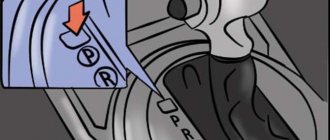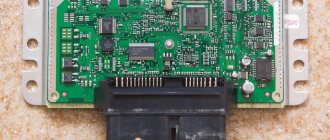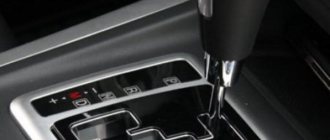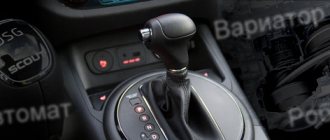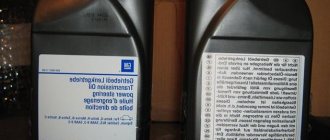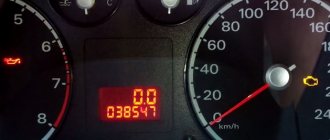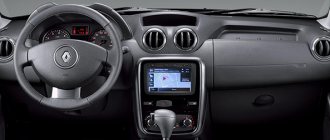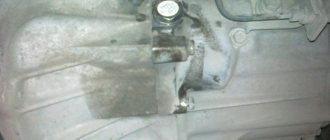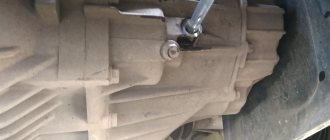Automatic transmission is one of the most popular gearbox variations. It has differences from manual transmission in operation and designations. When working with it, you can see different icons and letters, although the meaning of the latter is general. Also, different manufacturers may have slightly different letter designations. This article will help you understand letter designations and factory markings.
Automatic gearbox
We will look at classic modes, additional and special ones. We will also understand the types of boxes in order to understand cars even more effectively. After our article, you will be able to easily figure out which mode to turn on and in which situation.
Designations of box types
There are different types of automatic transmissions, and they are also designated by different abbreviations. The instructions for the car indicate the type of box used in it. Knowing the basic abbreviations of the types of “machine gun” will help to identify it. There are 4 such types in total (among the most popular).
different types of automatic transmission
- DSG (Direct Shift Gearbox) is a VAG gearbox model. It is a robotic preselective gearbox model with two clutches, it can be “wet” or “dry”. Essentially ordinary mechanics, but gear shifting occurs via a control unit and servos.
- MTA (Manual Transmission Shifted Automatically / robot) - used in premium car models. There is no clutch pedal; gears are changed using drives. And the computer regulates them.
- AT (Automatically Transmission) is the common name for all automatic transmissions (classic automatic transmission). As a rule, they are based on a classic hydromechanical design and are quite reliable.
Designation of gearbox types
Different types of automatic transmissions have different names from each other, which are contained in easily recognizable abbreviations. Knowing what the letters mean, you can understand from the car manual which gearbox it is equipped with and what it is capable of. In modern cars there are:
- CVT or Continuous Variable Transmission, or simply “variator”. It features continuously variable gear shifting. The boxes operate very smoothly, but their reliability is somewhat lower than that of conventional automatic machines.
- DSG, or Direct Shift Gearbox. This gearbox is robotic and has two clutches. It is based on a manual gearbox, improved by an electric control module and servos, with the help of which gears are changed.
- AT or automatic transmission. It is a classic hydromechanical design. It is very reliable, as it is time-tested.
- MTA or Manual Transmission Shifted Automatically, or "robot". The name speaks for itself - this gearbox is completely robotic. It doesn't have a clutch pedal.
What these or those letters mean can be found out both from the manufacturer, seller, and in open sources on the Internet. Don't act at random when driving a new car. It is better to familiarize yourself in detail with the capabilities of the existing gearbox in order to use it correctly in the future 100%.
Factory designations on the automatic transmission
Each manufacturer produces a certain range of automatic transmissions. Knowing the model number is necessary for the correct selection of spare parts for automatic transmission repair or replacement. There are already a lot of such models and each has a designation. By the way, some box models from the same manufacturer can provide almost complete compatibility.
You can find out the transmission model from the documents for the car, look at the car make, gearbox type, and year of production. You can also look by country.
Each automaker uses its own numbering system for automatic transmission models and modifications. Although the basis is the same, let’s look at a specific example. Let's take the Subaru Impreza TZ1B4ZU5AA automatic transmission.
T (Transmission) - transmission;
Z is the modification letter. Automatic transmission permanent all-wheel drive without center differential;
1B4 – 4-speed automatic transmission.
Z - permanent all-wheel drive 4AT with MP-T
U5AA - internal subnumber for ordering spare parts.
In the cabin
The automatic transmission selector is what the motorist most often interacts with; it is also responsible for changing gears. You need to know its designations. To understand which mode to choose in which situation. Also, the indicators of the current automatic transmission gear are transmitted to the dashboard. Most modern car models (a couple of years old).
How to start driving an automatic transmission
The driving theory is this. Driving a car with an automatic transmission starts with:
- Get behind the wheel and start the engine. The indicators on the panel should light up. The lever must be in position P or N. Wait 10 seconds, the fuel pump will turn on;
- Press and hold the brake pedal;
- Move the lever to position D.;
- Smoothly release the brake pedal. The car will immediately start moving. All you have to do is press the gas.
For reverse:
- Stop completely. Press the brake;
- Put the lever in R mode;
- Release the brake and start moving.
Automatic does not tolerate aggressive driving. It is recommended to ride smoothly. The electronics need time to switch, otherwise the engine will wear out faster. Repairing a machine gun is an expensive thing.
As you can see, operating the automatic transmission is simple, enjoyable and safe. To drive, you need to remember the letter designations of the modes, carefully study the manual for using a car with an automatic transmission, and off you go.
Automatic box for designating letters and numbers
Now let’s look at what designations, and therefore operating modes, are available on automatic transmissions of most models. They are divided into classic (below), additional and special.
Automatic transmission on Grant
D or A
D is an abbreviation for the word Drive; this is the key operating mode in which the car starts moving. Some manufacturers write the designation A - Automate instead of the letter D, this is the same thing.
M
M (Manual) - the letter means that you can independently adjust the gear. Using +/- on the lever or on the steering wheel paddle shifters.
N
N (Neutral) - this letter stands for the usual “neutral”. That is, the wheels are not blocked, but no force is transmitted to them.
P
P (Parking) – the letter designates the parking mode, based on it, the car’s wheels are blocked and their movement is impossible.
R
R (Reverse) - the designation means turning on the reverse mode. If you select this mode, reverse gear will be engaged.
Automatic transmission - automatic transmission
All girls dream of an automatic transmission (popularly automatic). Since gear shifting occurs without driver participation. Let's look at the automatic transmission in a car.
An automatic transmission mainly has 4 forward and 1 reverse gears. Specific gears are selected automatically depending on the position of the selector lever.
Additional automatic transmission operating modes
E
E (Economic) – economy mode. Fuel savings occur because gears are changed at low engine speeds.
O.D.
OD (Over Drive) – more often, this button is found on the gearshift lever itself.
Literally this can be translated as “overdrive”; by default the mode is activated. In fact, it corresponds to the 5th gear of a manual transmission, when the secondary shaft rotates faster than the primary. There is no 5th gear on automatic transmissions, so this analogue was introduced. The transmission itself is needed to save fuel and engine resources. Otherwise, he would have to go through gears from 1 to 4. Suitable when driving at one speed (above 50 km/h), the mode itself turns on at a speed of ~40 km/h.
S
S (Sport) – providing the best driving dynamics by changing the gear when peak torque is reached.
W
W (Winter) – that is, “snowflake”, used on snowy or wet roads. To prevent slipping of the drive wheels and further skidding and other problems. It works on the principle of starting from a higher gear than first plus at low torque. This mode is activated by a special dedicated button with the inscription Winter, Hold or a snowflake icon.
Kickdown
Kickdown is a special mode in the automatic transmission, which is designed for fast acceleration. Here you need to press the gas pedal sharply all the way. In this case, a couple of gears will be dropped and the car will accelerate sharply. Suitable for overtaking.
Additional operating modes of the box
Created for additional comfort of using the machine. Additional automatic transmission modes allow you to save fuel, eliminate constant automatic switching, drive like Lewis Hamilton, protect yourself in winter and accelerate sharply.
E (Economic)
The box will automatically select the most economical gear shift mode. In this case, the acceleration may seem slower and the speed will be relatively low.
OD (Over Drive)
Over Drive should not be understood as super speed. It's just moving in a certain gear. It is very convenient for constant driving in a certain speed range. For example, at a speed of 60 - 80 km/h, there is a constant switching between third and fourth gears. By turning on OD, you can safely drive in 3rd gear without worrying about constant clicking noises. Turns on and off with the same button. In most models it turns off if the gas is pushed to the floor.
S (Sport)
Makes you feel like an athlete and enjoy fast driving. In this mode, upshifting occurs at higher speeds. This makes it possible to quickly accelerate, the dynamics of the car changes for the better. Fuel consumption also changes - it increases sharply.
W (Winter)
The winter mode of the box is convenient for driving on ice and snow. The car starts smoothly and accelerates slowly. The possibility of wheel slippage is almost eliminated.
Some manufacturers do not recommend using “WINTER” for long-term use.
Kickdown
Mode for those who like to “play checkers” on the road. It is activated when the gas pedal is pressed to the floor, and the automatic transmission switches one or two gears lower. Provides rapid acceleration. It helps well when overtaking, when you are tired of a truck barely pulling ahead or a Zhiguli car plodding towards the dacha.
Automatic transmissions differ from manual transmissions not only in the principle of operation, but also in the designations on the lever and next to it. They are easy to understand. Different brands of cars may have their own nuances. Therefore, if you have any doubts, it is better to find and carefully read the manufacturer's recommendations.
Special operating modes of the automatic transmission
By special operating modes, most often we mean modes, as in classical “mechanics”. Let's see what options there are.
2 or 2L
2 (2L) - equivalent (hereinafter means “not higher than the specified gear”) to 2 gear in a manual transmission. Can be used when driving on hilly, mountainous terrain, as well as on country roads
3 or D3
3 (D3) - equivalent to 3rd gear. The speed should be no higher than 80 km/h. And you need to turn it on during constant braking in order to achieve the best smoothness.
Special automatic transmission operating modes
Before you get behind the wheel of a new car, it is better to learn more about the driving features. Especially if it is a car with an automatic transmission.
Simple or normal mode - standard Drive. By turning on D, the machine will do everything for you. In combination with Drive, or separately, you can use special driving modes:
- 2 or 2L;
- 3 or D3;
- 4 or D4.
2 or 2L
The letter L is from the English word low - slowly. The two means that the car will move forward with such a shift, using second gear. In other words, 2, 2L or L means driving slowly in no higher than 2nd gear.
Using slow L mode is essentially the same as 1st gear in a manual transmission. Well suited for slow starts and driving on slopes, slippery and loose surfaces. While driving, you can effectively brake with the gearbox on a descent or when obstacles arise along the way.
Attention! On some all-wheel drive vehicles, L mode locks the differential. What is recommended to be done only when the car is stationary.
Starting in second gear allows you to reduce torque on the wheels and minimize the possibility of slipping. This is an off-road driving mode, but it is suitable for leisurely driving through city traffic jams and provides good engine braking.
There is no need to remember about saving in mode 2 or 2L. The engine consumes fuel in maximum quantities.
3 or D3
D, of course, drive and movement forward. The three limits shifting to no higher than 3rd gear. The car starts and moves in 2 - 3 - 2 gears. Shifting from 2 to 3 is done at a slightly higher rpm than usual. When the speed decreases, the transmission switches to 2 at lower than usual speeds.
In fact, this is the ideal mode for winter driving on slippery roads. Suitable for comfortable movement around the city, but with slow acceleration. However, engine braking is not very effective.
Fuel consumption, of course, is more pleasant compared to the 2L, but still leaves much to be desired.
4 or D4
Drive using 4 modes ensures normal start and driving in the ranges from 1 to 4 gears. Switching occurs without delay. Suitable for city driving, without heavy traffic jams, and for leisurely country driving.
The car consumes fuel moderately, as in normal city mode.
Additional modes
This is the normal operating mode of the automatic transmission without the use of “special effects”.
The so-called “economical” mode of operation of the automatic transmission. Used to ensure smooth, calm, measured movement of the machine. It is used in cases where you want to significantly reduce fuel consumption and the amount of harmful emissions.
Sport mode is the exact opposite of “economy” mode. Automation allows the box to use engine power to its fullest. There can be no talk of any fuel economy in sport mode. The car becomes more “dirty” and “gluttonous”, but the acceleration becomes really sharp.
"Upshift" or "overdrive" function. As a rule, overdrive is activated by a separate button on the automatic transmission lever. The transition (or exit) to this mode is indicated by a separate symbol on the dashboard. Essentially, this is engaging the extreme fourth or extreme fifth gear in the box. You can switch to “overdrive” only at speeds of 75-110 km/h. Moreover, this mode should be exited at speeds below 70 km/h. The main advantage of “overdrive” is the increase in vehicle dynamics and fuel economy at high speeds.
Winter mode. Found in some automatic transmissions. Sometimes indicated by a snowflake. Used exclusively when starting on a slippery surface. When switching to this mode, the transmission will start immediately from second or third gear.


